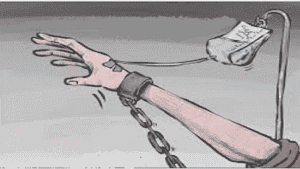by Jason Tarnow | Jan 19, 2024 | Crime, Legal Rights, Media, Police, Wheels Of Justice
How would you feel if your DNA was used to convict a family member?
Last week, news consumers were divided on the use of this tactic to identify and arrest Ibrahim Ali who was recently convicted of the murder and sexual assault of a 13 year old victim in 2017 in Burnaby.
Investigators went undercover at a 2018 Kurdish New Year Celebration handing out samples of tea in hopes of collecting DNA from their suspect – and it worked. Police were able to obtain a sample from a relative of the suspect. The sample was analyzed and compared against the DNA sample collected from semen found inside the victim, and the results were conclusive: the sample collected at the Kurdish New Year Celebration belonged to the brother of the whomever’s DNA was found inside the victim. This critical development resulted in the positive identification of Ibrahim Ali, his subsequent arrest and ultimately, his conviction.

However, certain civil liberties advocates have decried this investigative strategy, claiming it infringes on the privacy rights of people who have their DNA seized when they themselves are not suspected of any wrongdoing. Further, genealogical DNA testing is not frequently accessed or available technology in Canada. As a result, the analysis is often done in the United States, further stoking concerns from privacy experts. Police are required to maintain a “chain of custody” for all exhibits in a case. When the exhibits are forensic material, it is especially important that the chain of custody be meticulously maintained. This becomes increasingly difficult when exhibits leave the custody of Canadian agencies. Further, labs in the United States (and beyond) may not be accredited to the same standard as a Canadian lab. And of course, when private and sensitive material exists in the database of outside agencies, there is always a security risk.
Genealogical DNA testing and its use in criminal law is still very much in its infancy – in Canada, anyways.
This investigational technique gained notoriety in 2018 when it was used to identify and convict the Golden State killer in California, and made headlines again in December 2022 when it was used to identify Bryan Kohberger, currently awaiting trial for the murder of four college students at the University of Idaho.
Canadian Courts and legislators are no doubt paying close attention to developments in the field of Genealogical DNA testing. It is more important now than ever – in the age of ever-advancing scientific exploration and sophisticated tools like AI – that the Courts, and the law, can maintain pace.
by Jason Tarnow | Feb 24, 2022 | Crime, Media, Police
A Vancouver man suffering from long haul COVID-19 symptoms was successful in the judicial review of his 90-day Immediate Roadside Prohibition (“IRP”) after arguing that the Adjudicator breached his right to procedural fairness in his original review to RoadSafety BC.
On February 11, 2021, Peter Ronald Gibson was issued an IRP after the police officer alleged he refused to provide a sample. Mr. Gibson made 7 attempts into the Approved Screening Device, none of which successfully yielded a suitable sample. As a result, his vehicle was impounded for 30 days, and he was prohibited from driving for 90 days.
Mr. Gibson sought a review of his IRP to RoadSafety BC, delegate of the Superintendent of Motor Vehicles on the basis that he had a reasonable excuse for failing to provide a breath sample. In Mr. Gibson’s original review, he provided evidence in the form of his Affidavit. He also provided a letter from his physician that confirmed his diagnosis – he was suffering from long term symptoms as a result of COVID-19, including shortness of breath on exertion.
The letter reads:
“His physical examination shows evidence of post-viral reactive airways with sever forced expiratory wheeze. He has been given prescriptions for Flovent and Salbutamol inhalers today. This could contribute to his difficulty performing breathalyzer test during recent traffic stop”
The Adjudicator at RoadSafety BC rejected the letter from Mr. Gibson’s physician, stating that there was no evidence that the physician was aware of the “minimum flow rate (of breath)” required to provide a sample. Mr. Gibson also provided his own Affidavit, which confirmed that he had been referred for treatment, which included CT scans and chest x-rays, among other diagnostic tests.

Keep in mind that the role of the Adjudicator is to analyze whether Mr. Gibson had a reasonable excuse for failing to provide a sample. The analysis is done through review of the Report to Superintendent and all included materials, and also through review of all materials provided by the Applicant (in this case, Mr. Gibson). The Adjudicator may also rely on the Operator’s manual for the Alco-Sensor FST (the Approved Screening Device), which includes information such as proper operating temperature of the device, screen codes, and procedural standards.
Ultimately, the Adjudicator determined that Mr. Gibson’s version of events lacked credibility, and that his physician did not provide sufficient evidence that his medical condition would have prevented him from providing a suitable sample into the Alco-Sensor FST. In doing so, they advanced their interpretation of the testing requirements within the Operator’s manual – specifically, the wording used to describe the necessary airflow required to provide a sample:
“The Alco-Sensor FST has an automatic sampling system designed to ensure that a sample of deep lung air is obtained and analyzed. In order to trigger automatic sampling the subject must blow with a minimum flow rate, must produce a minimum breath volume, and blow for a minimum duration…”
On judicial review, Supreme Court Justice Tammen took issue with the Adjudicator’s interpretation of this issue. The Judge dissected the Adjudicator’s analysis and concluded that despite quoting the appropriate resource, the manual itself provided no information to estimate the “minimum” flow rate required.
Through the Adjudicator’s analysis, Justice Tammen determined that they had relied on information (relating to the required flow rate of a sample) that was not available to the Petitioner (or his physician) at the outset of his review with RoadSafety BC. This breached the Petitioner’s right to procedural fairness.
Justice Tammen directed that the Adjudicator’s decision confirming the IRP of the Petitioner be set aside, and that the matter be remitted to RoadSafety BC for a new hearing.
This case demonstrates a significant flaw in the IRP regime – that is, a blurring of the lines between adjudication and medical expertise. While adjudicators may have specialized knowledge of certain issues due to continued exposure via their employment, the boundaries in their role must be respected and enforced.

If you have received an Immediate Roadside Prohibition, an Administrative Driving Prohibition, or have been charged with Impaired Operation of a Conveyance, contact an experienced criminal lawyer at Tarnow Criminal Law as soon as possible. Our office is located in the heart of Richmond, only 20 minutes from downtown Vancouver on the Canada Line, and within 10 minutes of Vancouver International Airport (“YVR”).
Our firm is also licensed to work in the Yukon Territory, where the 90-day review process for impaired driving is an entirely different process. If you are facing impaired driving charges in the Yukon, contact our office as soon as possible for a consultation.
by Jason Tarnow | Feb 23, 2021 | Crime, Legal Rights, Police, Politics, Wheels Of Justice
On May 1, 2020, Prime Minister Justin Trudeau issued an Order in Council immediately banning the use, sale and transport of approximately 1,500 “assault” style firearms. This action was met with criticism from firearm owners, retailers and pro-gun advocates from across the country. A two-year amnesty period for restricted firearm owners will expire on April 30, 2022, which is around the time when Bill C-21 could come into effect.
At its first reading in the House of Commons on February 16, 2021, details about Bill C-21 emerged that created further frustration and confusion among Canadian firearm owners and retailers. Described as “an Act to amend certain Acts and to make consequential amendments (firearms)”, Bill C-21 will make substantive changes to both the Criminal Code and the Firearms Act, both of which are Federal legislation, thus impacting Canadians from coast to coast. It will also amend the Immigration and Refugee Act and the Nuclear Safety and Control Act.

Proposed amendments to the Criminal Code include:
- Increasing the maximum penalty of imprisonment for offences under Sections 95, 96, 99, 100 and 103 of the Criminal Code from 10 years to 14 years;
- Establishing a procedure that would allow any person to apply for an emergency prohibition order, or an emergency limitations on access order;
- Deem certain firearms to be prohibited devices for certain provisions;
- Create a new offence for altering a cartridge magazine to exceed its lawful capacity;
- Authorize employees of certain federal entities who are responsible for security to be considered as public officers for the purpose of section 117.07
One of the most concerning amendments, and the focus of today’s blog, involves establishing a procedure that would allow for any person to apply for an emergency prohibition order, or an emergency limitations on access order. The proposed amendment reads as follows:
Application for emergency prohibition order
110.1 (1) Any person may make an ex parte application to a provincial court judge for an order prohibiting another person from possessing any firearm, cross-bow, prohibited weapon, restricted weapon, prohibited device, ammunition, prohibited ammunition or explosive substance, or all such things, if the person believes on reasonable grounds that it is not desirable in the interests of the safety of the person against whom the order is sought or of any other person that the person against whom the order is sought should possess any such thing.
An ex parte application does not require notice to be given to the adverse party. This means that any person can make an application to a judge seeking the immediate prohibition (and subsequent seizure) of any of the items described in section 110.1(1). Success on the application is discussed next:
Emergency prohibition order
(2) If, at the conclusion of a hearing of an application made under subsection (1), the provincial court judge is satisfied that the circumstances referred to in that subsection exist and that an order should be made without delay to ensure the immediate protection of any person, the judge shall make an order prohibiting the person against whom the order is sought from possessing any firearm, cross-bow, prohibited weapon, restricted weapon, prohibited device, ammunition, prohibited ammunition or explosive substance, or all such things, for a period not exceeding 30 days, as is specified in the order, beginning on the day on which the order is made.
The seizure process will unfold one of two ways:
Warrant to search and seize
(4) If a provincial court judge is satisfied by information on oath that there are reasonable grounds to believe that a person who is subject to an order made under subsection (2) possesses, in a building, receptacle or place, any thing the possession of which is prohibited by the order, and that it is not desirable in the interests of the safety of the person, or of any other person, for the person to possess the thing, the judge may issue a warrant authorizing a peace officer to search the building, receptacle or place and seize any such thing, and every authorization, licence or registration certificate relating to any such thing, that is held by or in the possession of the person.
OR:
Search and seizure without warrant
(5) If, in respect of a person who is subject to an order made under subsection (2), a peace officer is satisfied that there are reasonable grounds to believe that it is not desirable, in the interests of the safety of the person, or of any other person, for the person to possess any thing the possession of which is prohibited by the order, the peace officer may, where the grounds for obtaining a warrant under subsection (4) exist but, by reason of a possible danger to the safety of the person or any other person, it would not be practicable to obtain a warrant, search for and seize any such thing, and any authorization, licence or registration certificate relating to any such thing, that is held by or in the possession of the person.
The seized items will remain in police custody for 30 days. When the Order expires, the seizing agency (police) must make an application for a Prohibition Order under Section 111(1) of the Criminal Code. This Application requires that the subject of the Order (the firearms/weapons owner) be given notice of the application, and the opportunity to respond in court. At this juncture, there are three ways the seized items can be returned to their owner:
- No application is made for a Prohibition Order under Section 111(1);
- If the hearing does not result in a Prohibition Order being made under Section 111(5);
- If the Order issued at the ex parte application is revoked
While this legislation seeks to establish an alternative procedure that gives the public power to seek protection from violence involving firearms and other weapons, it fails to address the possibility that this power could be abused. Currently, the law requires that an individual report their concerns to the police, who would then engage in an investigation to determine whether a seizure is necessary. When citizens assume this authority, there are a myriad of complications that could pose negative consequences not only to the potential subject of the Order, but to whomever makes the ex parte application. It requires that they take the law into their own hands – something that law enforcement regularly counsels against.
Bill C-21 is still in the early stages of the legislative process, but has garnered both support and criticism from those it will protect, and those it will harm.
by Jason Tarnow | Oct 2, 2020 | Crime, Legal Rights, Media, Police, Politics, Wheels Of Justice
Whenever incidents relating to terrorism in Canada hit the news, the eyes of Canadians widen with revolt. Recent headlines elicited a similar response, with a healthy dose of confusion and curiosity added to the mix.

On September 21, 2020, criminal charges were announced against 25 year old Ontario resident Shehroze Chaudhry – but not due to allegations of committing acts of terrorism. Rather, Chaudhry has been charged under Section 83.231(1) of the Criminal Code – perpetrating a hoax regarding terrorist activity:
83.231 (1) Every one commits an offence who, without lawful excuse and with intent to cause any person to fear death, bodily harm, substantial damage to property or serious interference with the lawful use or operation of property:
(a) conveys or causes or procures to be conveyed information that, in all the circumstances, is likely to cause a reasonable apprehension that terrorist activity is occurring or will occur, without believing the information to be true; or
(b) commits an act that, in all the circumstances, is likely to cause a reasonable apprehension that terrorist activity is occurring or will occur, without believing that such activity is occurring or will occur.

Chaudhry was a frequent guest on an award winning New York Times podcast known as “Caliphate”. He spoke, in gruesome detail, of his time as an ISIS executioner in Syria, among other things. But the charges levelled against him assert that his personal experiences as an ISIS soldier are fabricated.
While the NYT claimed to have verified his role in ISIS, he gave conflicting accounts to CBC, even going so far as to say he would take a polygraph to prove he had never killed anyone. He likely thought this would absolve him any criminal liability relating to terrorism offences in Canada, but the charges against him refute this misconception.
The details released from the police don’t specify if any other person was harmed or killed due to the alleged yarn by Chaudhry, but they will play a determinative role if he is convicted. The sentences range from a fine and imprisonment in a provincial correctional institution if prosecuted summarily, to life imprisonment should Crown proceed by indictment.
Chaudhry’s case demonstrates that Canadian jurisprudence condemns all activity relating to terrorism – whether it’s the real deal or not.
by Jason Tarnow | Apr 21, 2020 | Crime, Criminal Attorney, Legal Aid, Legal Rights, Media, Politics, Uncategorized, Wheels Of Justice
It has been over one month since the Courts of British Columbia significantly curtailed operations in an attempt to combat COVID-19.

For many of those who work in the legal field, it was this development that made it all real. It quickly became clear that the novel coronavirus had the potential to spread quickly, and the confined space of a courtroom serves as ideal grounds for transmission.
Despite the coronavirus acting as a proverbial wrench in the gears of justice, the judicial system continues to putter along. This is largely due to increased utilization of technological tools like video/conferencing for court appearances and swearing of affidavits, and relaxing restrictions when it comes to fax/electronic filing of court documents.
Video conferencing isn’t new to the BC court system. As early as 2002, Judges across the province agreed that the technology improved procedural efficiency by facilitating witness testimony from distant locations and allowing interim appearances by video involving counsel from other jurisdictions. Judges also noted the value of video- conferencing for inmates at correctional centres – defeating the purpose of transferring multiple inmates from various correctional centres to various courthouses. The bottom line is that modernizing certain aspects of the criminal justice system makes sense financially and systemically – and events like COVID-19 demonstrate how it can have occupational benefits too.
At present, there is enormous value in modernizing certain judicial processes for two reasons – one, to limit face-to-face interactions between judicial staff, defence counsel and an Accused person, and two, to mitigate the consequences of what can only be described as colossal delay.
In reducing operations, the majority of criminal trials scheduled between March 18, 2020 and June 1, 2020, have been adjourned generally to dates in June and July, 2020. Cases that are deemed to be of an urgent nature will be able to proceed, although in a procedural sense, things will look different – for example, witnesses who would ordinarily appear before the Court to give evidence may be authorized to testify via video. For the most part, however, trials will proceed at a date that is likely much later than originally anticipated.

The situation is more grim for accused persons in custody awaiting their trial. Inmates are, of course, among the most vulnerable to contracting the novl coronavirus – a concern that was a topic of discussion before the courts closed – but didn’t really become part of the actual narrative until it was too late Trials for accused persons in custody have also been adjourned (for trials scheduled between March 23 and May 16, 2020). Sentencing hearings and bail hearings for accused persons will proceed. This could be positive – for some, it might result in their immediate release from the correctional system. For others, further incarceration for as little as an additional 90 days in custody will be devastating, a potential death sentence.
It is far too early to gauge how overwhelmed the court system will be at the return to business as usual – but when you consider that there was a huge backlog before COVID-19 shut it all down, it seems only reasonable that extreme measures – such as implementing night/weekend court, and permanently authorizing certain modernization measures – will need to be taken to truly return to normal.








